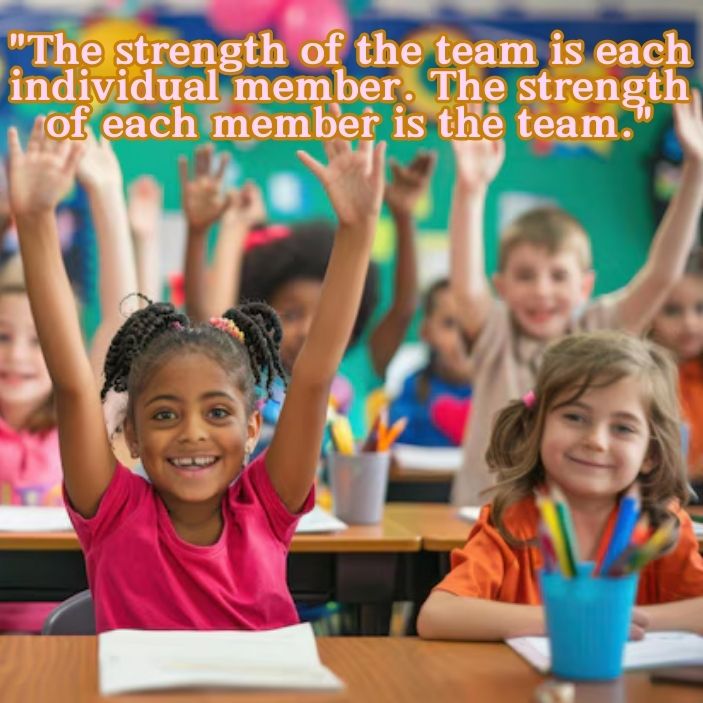
“Learning to Collaborate: The Role of Teamwork in Academic Achievement”
In today’s rapidly evolving world, the ability to collaborate effectively is one of the most essential skills students can develop. The power of teamwork in education goes beyond academic achievement; it prepares students for real-world challenges and equips them with the skills needed to thrive in the workplace and society. The global economy, technological advancements, and increasing interconnectedness demand that individuals work together across disciplines, cultures, and geographic boundaries. As such, education systems must prioritize the development of collaborative skills that will empower students not only to succeed in school but also to adapt to the ever-changing demands of the future.
The Importance of Teamwork in Education
Teamwork, or collaborative learning, is defined as the process of students working together towards a common goal, using shared knowledge and resources. The traditional model of education, where students work individually and compete for grades, is increasingly being replaced by approaches that emphasize cooperative learning. This shift reflects a broader understanding that teamwork is not only valuable but necessary for success in the 21st century.
- Skills Development: Teamwork fosters the development of critical life skills such as communication, problem-solving, negotiation, and conflict resolution. These are the very skills that employers look for when hiring, as they are vital in the modern workforce. Collaborative learning enables students to learn from one another, share diverse perspectives, and build on each other’s strengths, ultimately enhancing the depth and breadth of their knowledge.
- Enhanced Social Interaction: Working in teams helps students develop social skills that are essential for their personal and professional growth. It provides opportunities to interact with peers from different backgrounds, which can promote empathy, tolerance, and respect for diversity. These social interactions encourage students to think critically about their own viewpoints, develop a sense of responsibility, and engage in constructive dialogue.
- Building Trust and Accountability: In any team, trust is essential for success. Collaborative learning environments teach students how to build and maintain trust among teammates. Students quickly learn that they are responsible not only for their own work but also for the success of the group as a whole. This fosters a sense of accountability and encourages students to contribute meaningfully to the team’s efforts.
- Promoting Active Learning: Teamwork in education shifts students from passive recipients of information to active participants in their learning process. When students work together in teams, they are more likely to engage in critical thinking, ask questions, and make connections between concepts. This active learning process not only enhances their understanding but also promotes deeper cognitive engagement, helping students retain knowledge more effectively.
Benefits of Teamwork Beyond the Classroom
While the benefits of teamwork in education are often discussed in terms of classroom performance, these skills extend far beyond the school setting. Teamwork prepares students for future challenges in various contexts:
- Workplace Success: In the professional world, teamwork is often the foundation of organizational success. Almost every industry relies on individuals working together to achieve shared objectives, whether it’s in the form of project teams, departmental collaboration, or cross-functional initiatives. Students who learn to collaborate effectively are better prepared for these scenarios, making them more attractive candidates to potential employers.
- Global Competence: Teamwork also helps students develop the skills needed to work in a globalized environment. In many professions today, employees are often required to work with people from diverse cultural and linguistic backgrounds. Through collaborative learning, students gain an appreciation for different perspectives, which helps them develop intercultural competence—a vital skill in an increasingly interconnected world.
- Innovation and Creativity: Collaboration often sparks creativity, as diverse ideas and viewpoints come together to form innovative solutions. When students work in teams, they combine their knowledge, creativity, and experiences to solve problems in unique ways. The ability to collaborate in order to generate new ideas and solutions is crucial in fields such as technology, business, and the arts.
Strategies for Building Collaborative Skills in Education
To truly harness the power of teamwork in education, teachers and educational institutions must create environments that foster collaboration. Here are some effective strategies for building collaborative skills in students:
- Project-Based Learning (PBL): PBL is a teaching method where students work in teams to complete a project or solve a real-world problem. This approach encourages students to take ownership of their learning, engage in problem-solving, and use critical thinking skills. The project format provides a clear structure for teamwork, with defined roles, deadlines, and deliverables, which helps students practice accountability and communication.
- Group Assignments and Peer Reviews: Assigning group projects that require collaboration not only encourages teamwork but also allows students to practice skills like negotiation and compromise. Peer review processes can also be an effective way to ensure that all students are engaged in the work. Through feedback and constructive criticism, students can refine their teamwork abilities and contribute to the growth of their peers.
- Role Assignments: To ensure that every team member is actively engaged and contributing, it is essential to assign specific roles within the group. This helps students develop a sense of responsibility and accountability for the group’s success. Roles can vary, such as facilitator, researcher, writer, or presenter, depending on the project. This strategy allows students to develop different facets of teamwork and leadership.
- Collaborative Technology Tools: In today’s digital world, technology plays a critical role in facilitating collaboration. Tools like Google Docs, Slack, or Trello allow students to work together on documents, communicate instantly, and track progress. These tools provide students with the opportunity to work in virtual teams, preparing them for the kind of digital collaboration that is becoming increasingly common in professional settings.
- Structured Reflection: After completing a group project, it is helpful for students to reflect on their teamwork experience. Structured reflection activities, such as group discussions or individual journals, allow students to assess their teamwork strengths and weaknesses. This reflection encourages students to think critically about how they can improve their collaboration skills for future projects.
Conclusion
In conclusion, the power of teamwork in education cannot be overstated. As we move into an increasingly collaborative and interconnected world, the ability to work effectively with others has become a fundamental skill that students must develop. Collaborative learning empowers students by teaching them essential skills such as communication, problem-solving, and conflict resolution, all of which are invaluable in both personal and professional contexts. By implementing strategies like project-based learning, group assignments, and the use of digital collaboration tools, educators can foster an environment where teamwork thrives, preparing students for success in the workforce and beyond. Ultimately, teamwork is not just about completing tasks together; it’s about learning from each other, growing collectively, and developing the social and emotional intelligence needed to succeed in the future. As the educational landscape continues to evolve, prioritizing teamwork will help shape students who are not only knowledgeable but also adaptable, empathetic, and ready to tackle the challenges of tomorrow.














